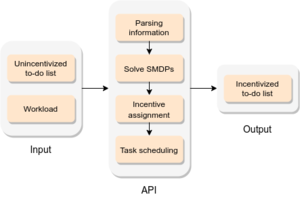Optimal To-Do List Gamification
2020
Technical Report
re
What should I work on first? What can wait until later? Which projects should I prioritize and which tasks are not worth my time? These are challenging questions that many people face every day. People’s intuitive strategy is to prioritize their immediate experience over the long-term consequences. This leads to procrastination and the neglect of important long-term projects in favor of seemingly urgent tasks that are less important. Optimal gamification strives to help people overcome these problems by incentivizing each task by a number of points that communicates how valuable it is in the long-run. Unfortunately, computing the optimal number of points with standard dynamic programming methods quickly becomes intractable as the number of a person’s projects and the number of tasks required by each project increase. Here, we introduce and evaluate a scalable method for identifying which tasks are most important in the long run and incentivizing each task according to its long-term value. Our method makes it possible to create to-do list gamification apps that can handle the size and complexity of people’s to-do lists in the real world.
| Author(s): | Jugoslav Stojcheski and Valkyrie Felso and Falk Lieder |
| Journal: | ArXiv Preprint |
| Year: | 2020 |
| Department(s): | Rationality Enhancement |
| Research Project(s): |
Computing Optimal Incentive Structures
|
| Bibtex Type: | Technical Report (techreport) |
| Paper Type: | Technical Report |
| DOI: | 10.48550/arXiv.2008.05228 |
| State: | Published |
| URL: | https://doi.org/10.48550/arXiv.2008.05228 |
|
BibTex @techreport{Stojcheski2020Optimal,
title = {Optimal To-Do List Gamification},
author = {Stojcheski, Jugoslav and Felso, Valkyrie and Lieder, Falk},
journal = {ArXiv Preprint},
year = {2020},
doi = {10.48550/arXiv.2008.05228},
url = {https://doi.org/10.48550/arXiv.2008.05228}
}
|
|




